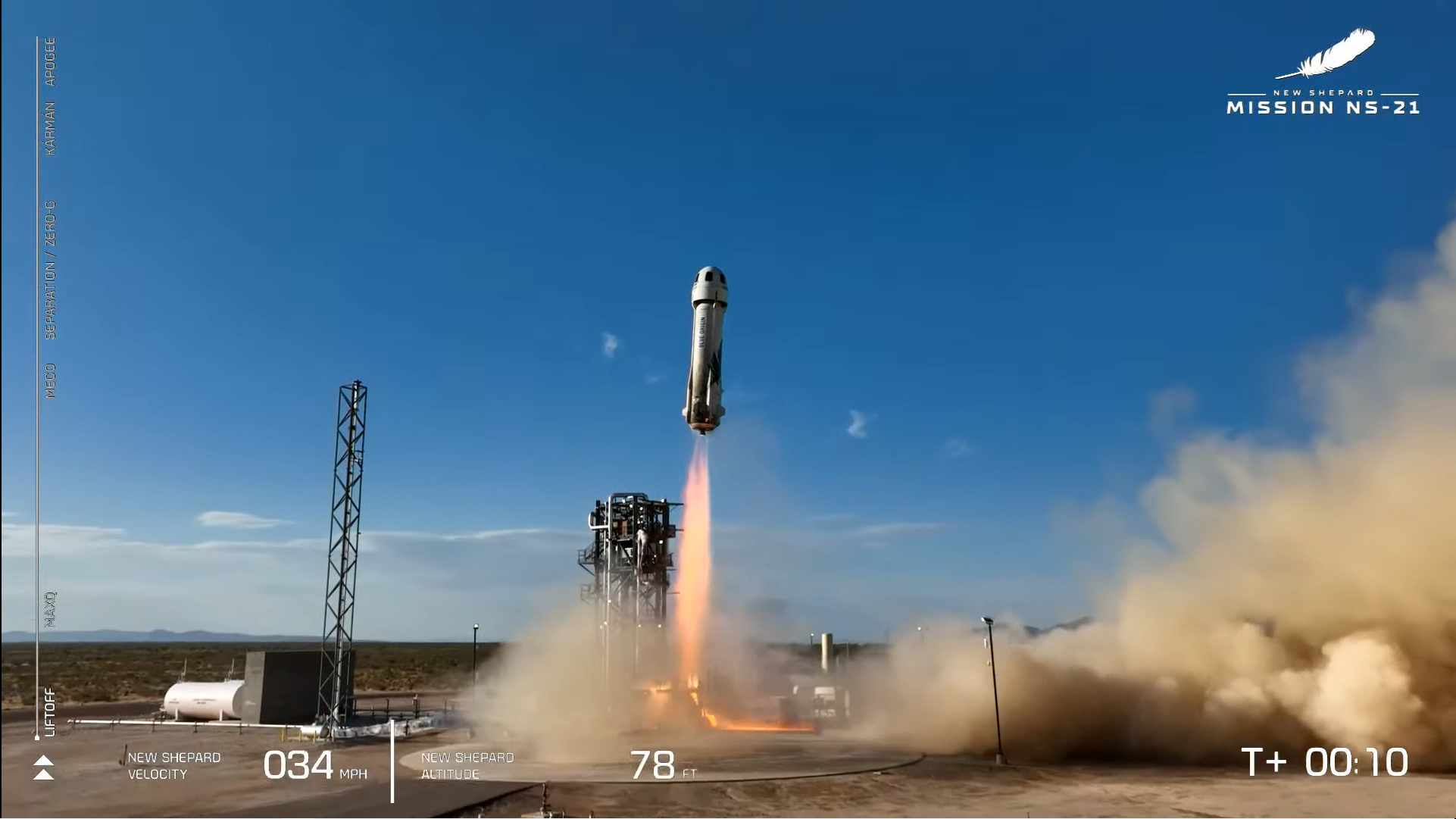Blue Origin now has five crewed spaceflights under its belt.
Jeff Bezos' company sent six people to suborbital space today (June 4), acing its fifth human spaceflight mission and notching several milestones in the process.
The action started at 9:25 a.m. EDT (1325 GMT), when Blue Origin's New Shepard vehicle lifted off from Launch Site One, the company's facility in West Texas, about 25 miles (40 kilometers) from the town of Van Horn.
It was all over just over 10 minutes later, when the New Shepard capsule and its six passengers touched down under parachutes, sending up a plume of desert dust when it hit the ground. During the flight, the crew reached a peak of 347,538 feet (106 kilometers) above ground level.
Related: Blue Origin's NS-21 mission (reference)

New Shepard consists of a rocket and a capsule, both of which are reusable. The booster comes down shortly before the capsule does, making powered vertical landings, as the first stages of SpaceX Falcon 9 orbital rockets do.
Today's flight was the 21st overall for Blue Origin and New Shepard, which explains the mission moniker: NS-21. It was the second crewed flight for the company this year, following NS-20, which launched and landed on March 31.
Get the Space.com Newsletter
Breaking space news, the latest updates on rocket launches, skywatching events and more!
The other three crewed New Shepard flights occurred in July, October and December of last year, respectively. Engineer and investor Evan Dick was one of the crewmates on that December flight, known as NS-19. And he flew again today on NS-21, becoming the first-ever repeat New Shepard passenger.
Crewmembers from NS-20 left messages for the capsule communicator to read to the crew before flight. In addition, Apollo astronaut Charlie Duke, who flew on the Apollo 16 mission 50 years ago this year and who served as capsule communicator on Apollo 11, sat in mission control before flight to wish the NS-21 crew well.
"Congratulations on this flight that you're about to embark on," Duke said.
"I know you're going to have an exciting adventure, just as I did 50 years ago," he added. "Have a great ride and I look forward to seeing you when you get back. Godspeed."
Several other NS-21 firsts came courtesy of crewmember Katya Echazarreta, a 26-year-old science communicator who became the first Mexican-born woman, and the youngest American woman, ever to reach space.
Echazarreta's seat was sponsored by the nonprofit Space For Humanity, which seeks to expand our species' access to space. She's the first of Space For Humanity's "citizen astronauts" to reach the final frontier. (Her work for the group is not done, however; citizen astronauts are expected to help implement the positive aspects of the overview effect — the perspective shift that results from seeing our planet from above — here on Earth after they land.)
The other four passengers on NS-21 were civil production engineer Victor Correa Hespanha, who became the second Brazilian to reach space; Jaison Robinson, who was a finalist on the TV show "Survivor: Samoa" in 2009 and later co-founded a company called Dream Variations Ventures; Victor Vescovo, an accomplished explorer who co-founded the private equity investment firm Insight Equity; and Hamish Harding, chairman of the business-jet brokerage Action Aviation, who is also an explorer and adventurer who holds several aviation world records.
You can read more about all of them in our NS-21 crewmembers story.
Like Echazarreta, Correa Hespanha flew on someone else's dime; his seat was sponsored by the Crypto Space Agency. The other four passengers on NS-21 apparently paid their own way, but it's unclear how much they had to shell out; Blue Origin has not divulged its ticket prices.
For perspective: The company's main rival in the suborbital space tourism industry, Richard Branson's Virgin Galactic, currently charges $450,000 for a seat on its VSS Unity space plane. VSS Unity has flown to space four times to date, but it hasn't yet carried paying customers. Virgin Galactic plans to begin full commercial passenger operations with the vehicle in early 2023.
NS-21 was originally supposed to launch on May 20, but Blue Origin delayed the launch to investigate a possible issue with one of New Shepard's backup systems.
Mike Wall is the author of "Out There" (Grand Central Publishing, 2018; illustrated by Karl Tate), a book about the search for alien life. Follow him on Twitter @michaeldwall. Follow us on Twitter @Spacedotcom or on Facebook.
Join our Space Forums to keep talking space on the latest missions, night sky and more! And if you have a news tip, correction or comment, let us know at: community@space.com.

Michael Wall is a Senior Space Writer with Space.com and joined the team in 2010. He primarily covers exoplanets, spaceflight and military space, but has been known to dabble in the space art beat. His book about the search for alien life, "Out There," was published on Nov. 13, 2018. Before becoming a science writer, Michael worked as a herpetologist and wildlife biologist. He has a Ph.D. in evolutionary biology from the University of Sydney, Australia, a bachelor's degree from the University of Arizona, and a graduate certificate in science writing from the University of California, Santa Cruz. To find out what his latest project is, you can follow Michael on Twitter.









